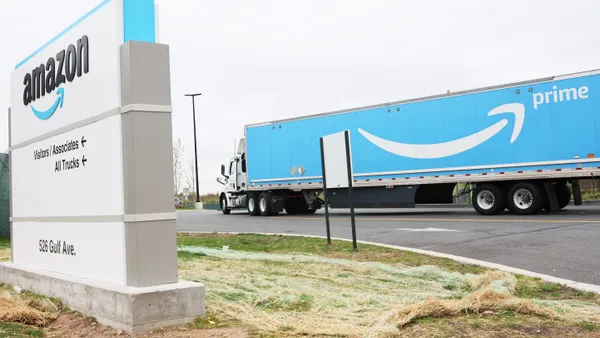Dive Brief:
- Trucking demand, measured by DAT's load-to-truck ratio, showed signs of growth across van and reefer volume in December. The modes were up 32% and 36% year-over-year (YoY) respectively, but flatbed demand was down.
- Not all indicators tell the same story. The Cass freight index showed shipment volume dropped almost 8% YoY in December, which Cass called the "steepest [YoY] decline since the Great Recession of 2008-2009."
- Spot rates were down across the board YoY for December, dropping 7% for van, 11% for flatbeds and 6% for reefers, according to DAT's numbers. But they did reach an 11-month high in December, DAT said.
Dive Insight:
Gains in the load-to-truck ratio show carriers are finally getting the signal that they need to cut capacity. The failure of hundreds of trucking companies has also contributed to capacity cuts. While truck posts were up YoY in December, they were down from November. Spot posts, meanwhile, were up month-over-month and YoY in December, according to DAT.
Taken together, there are signs the market is moving in the direction carriers have been waiting for — experts suggest this could happen in the second half of 2020. But for now, it's still a shipper's market with plenty of capacity and relatively low rates.
Earlier this month, analysts with UBS lowered fourth-quarter earnings guidance for five major trucking companies: Heartland Express, Hub Group, J.B. Hunt, Schneider National and Werner Enterprises. J.B. Hunt reported its earnings two days later and missed on earnings and revenue.
J.B. Hunt CFO David Mee said the company had a strong quarter when it came to its contractual business but struggled with the spot market where rates continue to flounder.
"Most of this freight was contractual business, where we experienced very competitive pricing gain to bid season over the prior several quarters," Mee said on the call. ;"However, we did not experience similar competitive pricing in the third-party carrier markets, nor did we capture a materially larger portion of spot activity during the fourth quarter, hence, our margins were squeezed."
J.B. Hunt also said high levels of capacity in the trucking market hurt its intermodal business. Currently, the rates in the trucking market are favorable to shippers and don't make intermodal as desirable.
But the speed at which spot rates are declining is slowing, the UBS analysts said. It noted steps to reduce capacity could lead to improvements in 2020 and a tighter freight market that favors carriers rather than shippers.
"Certainly, it feels, from a supply-side, like a tighter environment than really what people are talking about," Shelley Simpson, the chief commercial officer at J.B. Hunt, said of capacity on the earnings call. Simpson noted the closure of multiple trucking companies throughout the year.
For carriers, this could mean a few more difficult months ahead.
Ken Adamo, the chief of analytics at DAT Solutions, said van rates will probably remain flat for the first quarter of 2020 compared with the fourth quarter of 2020.
"In the spring we expect year-over-year rate comparisons to turn positive for the first time since September 2018," Adamo said in a statement emailed to Supply Chain Dive.
Cass agreed with this assessment in its December report, suggesting that increased rates at the beginning of December were "unusual and that spot rates are likely to fall again in January, unless significant capacity is removed due to fleet failures."














